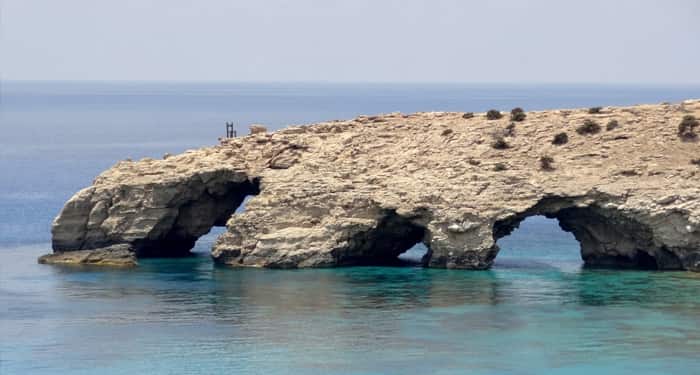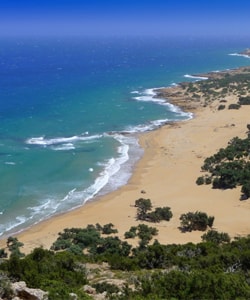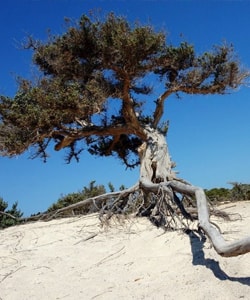Gavdos is the southernmost part of Europe, located 32 nautical miles away from Paleochora, 22 from Chora Sfakion and 170 fromTobruk, Libya. It is a small island, just 30 km squares with triangular shape, with a maximum length of 10 km and width 5km.
A few residents live on the island throughout the year and the infrastructure for tourists is very basic. According to the census of 2011, Gavdos has 152 permanent residents. In summer, the total population reaches 3500, most of whom are campers. The port of Gavdos is Karave. It’s capital vis Kastri, while the southernmost inhabited village is Vatsiana with 31 residents (2011). Gavdos is a fishing heaven, with few but good-hearted people who with patience wait for better days of summer to see their island swarmed with visitors.
Nature
Gavdos, together with the neighboring islet Gavdopoula, are a migratory bird station in their long journey from Africa to Europe and vice versa, and a shelter for the endangered species of mediterranean monk seal and loggerhead sea turtle.
Gavdos is a unique gem of Southern Europe, away from the bustling "civilized" world, with wild beauty, crystal blue waters, dreamy sunrises, breathtaking sunsets, amazing coastline and beaches, where junipers reach the sea; an island of great beauty that deserves to be discovered. The only thing that you have to do, is to relax on the extensive sandy beaches of Sarakiniko and Agiannis and hike to its inaccessible places and virgin beaches.
Pines, junipers and endemic species of flora adorn the island, and heather, anger and more aromatic herbs leave their fragrances in the air. It is no coincidence that the Gavdos joined the Natura 2000 program.
Well-designed trails offer wonderful tours on the island: from Korfos to Tripiti, from Kastri to Ambelos, from Chamourio to Kedre and Lavrakas, from Vatsiana to Korfos, from Saint Panteleimon to Kastri and other routes. Tours that require appropriate shoes, sunscreen and of course supplies, particularly water.
History
Ogygia, Ogyges, Goygia, Gavgia, Gavdos, Claudius, Gozo, Godoy, Claudia, Claudos are some of the names with which Gavdos was known during various periods of history. Names that are indicative of the continuous habitation of the island from Neolithic times until today. Signs of uninterrupted habitation that can be seen in the excavations of Sarakiniko, in Korfos, the Agiannis and Lavrakas.
The Apostle Paul passed to the lee of Gavdos on his final voyage to Rome. After leaving Crete, a storm swept up blowing his ship off course such that he passed near to the island. The account is recorded in Acts 27:16 as: “… we sailed to the lee of Crete opposite Salmone … and came to a place called Fair Havens, near the town of Lasea … after the fast [Day of Atonement in late September] … the majority decided that we should sail on, hoping to reach Phoenix and winter there … so they weighed anchor and sailed along the [southern] shore of Crete … the ship was caught by the storm … we passed to the lee [south] of a small island called Cauda, we were hardly able to make the lifeboat secure.” (Acts 27:7-16; NIV translation)
Later, at the time of the Byzantine Empire, the island had some 8,000 inhabitants (900-1000 AD) and was served by 3 bishops and an archbishop. During the Ottoman Empire's reign on the island, which lasted from 1665 up until 1895, Gavdos was known as Gondzo. During this period the population decreased considerably to only 500 inhabitants in 1882. A reference to Saracens on the island survives - a beach is named Sarakiniko.
In the 1930s the island was used as a place of exile of communists; more than 250 people were exiled including leading figures of the Greek movement, such as Markos Vafiadis. During World War II, allied forces evacuated some forces to Gavdos following the German victory in the Battle of Crete. Later on, the general phase of urbanization that started in other parts of Greece in the 1960s, took place in the 1950s on Gavdos. During that period the islanders exchanged their land on Gavdos with ex-Turkish land on Crete, which had now become exchangeable via the state. Upon settling in Crete they created a community known as Gavdiotika, which is part of the town of Paleochora.
After many years of isolation, in 1996 the island came to foreground through the media. In a NATO exercise Gavdos was the focal point of a confrontation between Greece and Turkey. Following that, prime minister Simitis, visited Gavdos and announced a five-year, €1.5 million plan for Gavdos' development. In 2001, Costis Stephanopoulos, the Greek President, inaugurated a telemedicine centre on Gavdos, an island which has never had a doctor. This project, however, failed as the island's infrastructure could not provide the necessary power required by the centre. In 2002, the island was in the news again, due to the arrest of the leader of the extremist group November 17. The leader, Dimitris Koufontinas, had been living openly for several years on Gavdos as a beekeeper.

Attractions
Apart from the excavations on the island, there are many interesting places you can see. Seventeen small, austere churches decorate the island. The main church is named Agia Triada after Holy Trinity and is located in Kastri. Apostle Paul passed from Gavdos and the 99 fathers with the Saint John the Hermit. Gavdos was once diocese.
Trademark of Gavdos is the old lighthouse at Ambelos that was once towered over the rugged southwest coastline, called Aspes, with almost vertical cliffs for about ten kilometers. Constructed in 1880 at an altitude of 368m, it was visible from a distance of 40 miles, the longest distance in the world then. It was bombed by the Germans in May 1942 and was almost completely destroyed. Today the lighthouse is, reconstructed, dominating again in the same place a few hundred meters before reaching Ambelos.
The lighthouse is one of the attractions. The building of the exiles in Sarakiniko, the Venetian fortress at Kefali, the Roman and early Christian ruins on the hill of Agiannis, the carved tombs in Lavrakas, the famous three arches of Kamareles in Tripiti, the excavations in Sarakiniko and Agiannis and of course the small folklore museum can be added in the attractions.
Infrastructure
Since rain is rare in Gavdos, there is little water available here. This is despite the futile efforts of the government for pumping water from wells. During dry years, there is no water even for shower. The problem of power, as mentioned earlier, is very important and demand is fulfilled by generators.
There are many abandoned terraces on Gavdos where farmers used to grow crops on the hillsides. There still is some agriculture on Gavdos.
The lighthouse tower serves as a cafe during the summer season; the complex also contains a museum on the history of the original lighthouse with several rooms of photos and antique equipment. Gavdos is home to the radio station Gavdos FM 88.8. In Kastri you will find the only post office on the island. You can also find a small clinic in Kastri (+30 28230 42195) and bank (ATM) in Karave port. There is a police station with a single policeman on the island (+30 28230 41109).

Proposed hiking trails
Gavdos is one of the best places for hiking and favored by all hiking clubs of Crete. The first suggested route is Lighthouse - Ambelos - Potamos - Pirgos and back. You should also not miss the trail from Korfos to Tripiti beach and back to Vatsiana, where you will see some of the most amazing landscapes in the isle. Lastly, the easy trail from Sarakiniko to Agiannis and Lavrakas is suitalble for everyone and you will meet the exotic side of Gavdos with the long pine- and juniper- wooded emerald beaches.
Gavdos can be reached either from Paleochora, Plakias, Sougia and Chora Sfakion. The routes are not standard, so one should consult the ferry companies. You can find information in ANENDYK website.
Port authorities are located in Sfakia (+30 28250 91292) or Paleochora (+30 28230 41214).













 General information about Gavdos
General information about Gavdos 




























































































